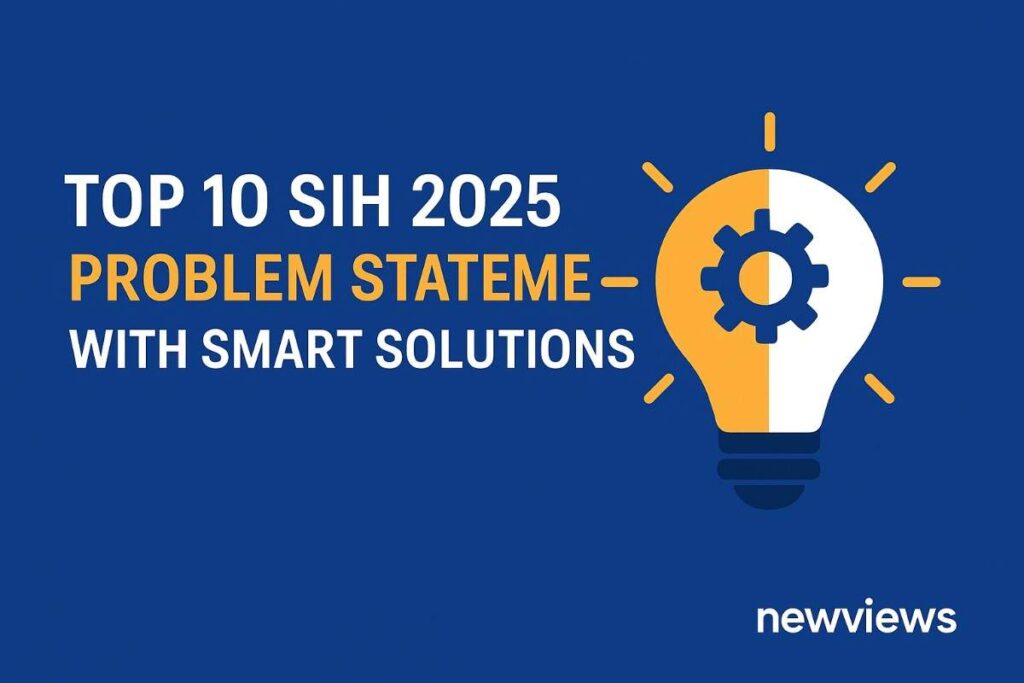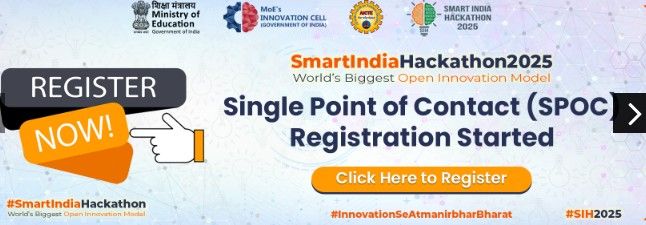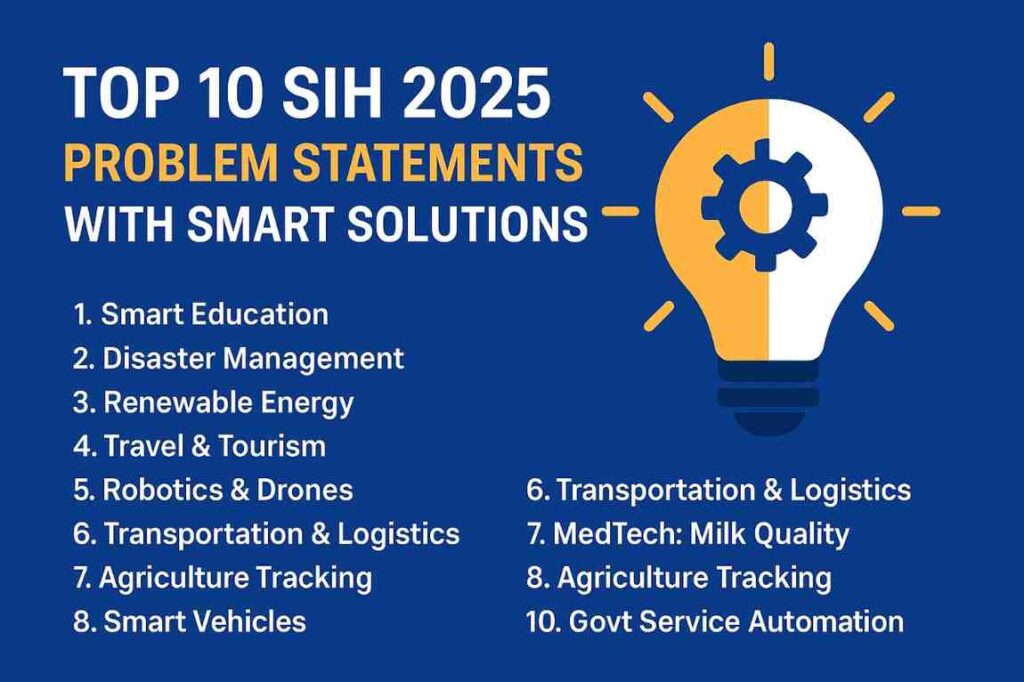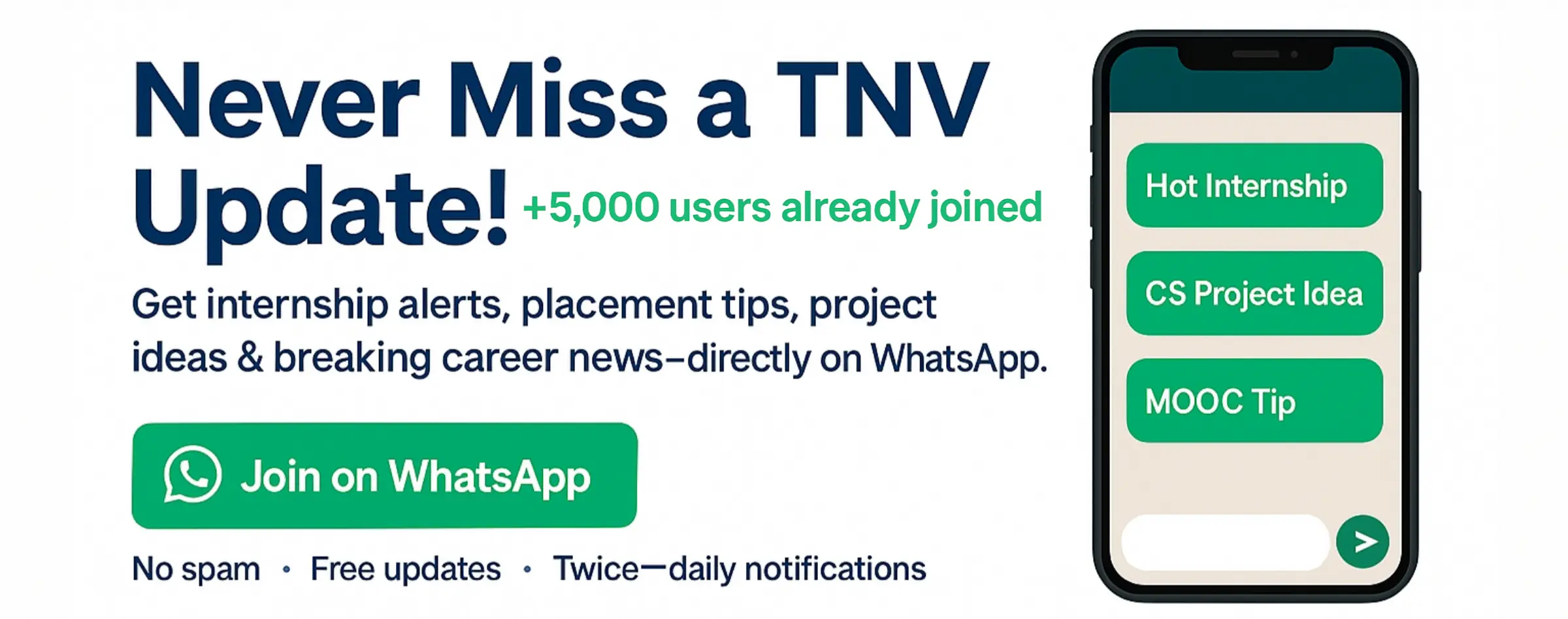The Smart India Hackathon (SIH) 2025 is one of the largest open innovation challenges in the world, empowering students to solve real-world problems with technology-driven solutions.

With over 300 problem statements submitted by ministries, state governments, NGOs, and private industries, the hackathon challenges students to create practical, scalable, and impactful solutions.
If you are preparing for SIH 2025, knowing the top problem statements with sample solutions will help you understand what kind of projects stand out. In this blog, we’ll cover the Top 10 SIH 2025 Problem Statements with Solutions, a problem-solution table, and key tips for winning the hackathon.
Why is SIH 2025 Important for Students?
Smart India Hackathon (SIH) 2025 is not just another competition; it’s a platform where students can showcase their creativity and problem-solving skills on a national level.
By working on real-life problem statements provided by government bodies, industries, and NGOs, students have the opportunity to apply their classroom knowledge to practical situations.
The Smart India hackathon also builds teamwork, leadership, and critical thinking skills. Students collaborate in groups, brainstorm innovative solutions, and learn how to handle deadlines under pressure.
This exposure helps them prepare for real-world challenges beyond academics. Most importantly, SIH 2025 opens doors to exciting opportunities like internships, mentorship, and even job offers.

For many students, it becomes a stepping stone to kickstart their professional careers while making a meaningful impact on society.
Top 10 SIH 2025 Problem Statements with Solutions
Here’s a quick table view of the Top 10 SIH 2025 Problem Statements for easy reference before we dive into details:
| SIH 2025 Problem Statement | Proposed Solution Idea |
|---|---|
| Digital Healthcare Access | AI-powered telemedicine + wearable health tracker |
| Smart Waste Management | IoT-based bins + recycling app with rewards |
| Agriculture Productivity | Drone monitoring + AI crop disease detection |
| Cybersecurity for Students | AI-based phishing detector + awareness app |
| Disaster Management | Real-time disaster alert app with drone support |
| Traffic & Road Safety | AI-powered smart signals + accident prediction |
| Renewable Energy Tracking | Blockchain-based energy monitoring system |
| Education for Rural Areas | Offline-first e-learning app in local languages |
| Financial Literacy for Youth | Gamified finance learning app with rewards |
| Women Safety in Public Spaces | Smart wearable + AI alerting system to police |
Also Check:
Complete Guide to Smart India Hackathon (SIH) 2025 Problem Statements
Lets explore in detail:
1. Digital Healthcare Management System
Healthcare is one of the most pressing areas where India requires digital transformation. Many government hospitals face issues with patient record management, appointment scheduling, and data sharing across institutions.
Problem Statement: Develop a Digital Healthcare Management System that integrates Electronic Health Records (EHR), real-time diagnosis support, and AI-powered prediction models to improve efficiency in hospitals.

Possible Solution: Students can design a cloud-based healthcare ecosystem that allows seamless patient record sharing across hospitals. Adding AI tools for predictive analysis can help doctors identify potential risks early.
Integration with Aadhaar-based authentication will ensure accurate identification, while telemedicine features can extend healthcare access to rural areas.
This solution not only streamlines hospital workflows but also brings inclusivity and accessibility to the healthcare system.
2. AI-Powered Traffic Monitoring & Road Safety
India is home to some of the busiest and most congested roads. Traffic mismanagement leads to accidents, delays, and rising pollution levels.
Problem Statement: Create an AI-powered traffic monitoring system that ensures smoother traffic flow, reduces accidents, and promotes safer driving practices.
Possible Solution: The project can use AI-based surveillance cameras and IoT sensors to monitor real-time traffic. Machine learning algorithms can predict congestion points and automatically adjust traffic signals. Additionally, integrating road safety alerts into a mobile app can notify drivers about speed limits, accident-prone areas, or ongoing construction.
Such systems not only improve daily commuting but also align with the Digital India Smart Cities initiative.
3. Smart Waste Management & Recycling System
Urban cities in India face massive waste management challenges. Despite several initiatives, segregation, recycling, and disposal remain inefficient.
Problem Statement: Build a Smart Waste Management System that uses technology to ensure waste segregation, optimized collection, and better recycling practices.
Possible Solution: Students can design smart bins with IoT-enabled sensors that send alerts when full. A mobile app can track garbage collection vehicles in real-time to ensure efficiency.
AI models can be integrated to identify recyclable materials automatically. Additionally, blockchain-based reward systems can motivate citizens to segregate waste properly.
This type of solution supports sustainability and contributes to India’s Swachh Bharat Mission.
4. Cybersecurity Solutions for Digital India
With India’s rapid digital growth, cyber threats and online frauds have also increased. There is a pressing need to strengthen cybersecurity infrastructure.
Problem Statement: Develop Cybersecurity Solutions that safeguard individuals, government portals, and organizations from phishing, data theft, and ransomware attacks.
Possible Solution: Students can design AI-driven platforms that detect unusual login behavior or fraudulent transactions. Blockchain technology can secure sensitive databases, while biometric authentication ensures stronger protection. A cyber awareness app can also be integrated to educate citizens about safe internet practices.
By solving this problem, teams can contribute to making Digital India safer and more reliable.
5. EdTech Platforms for Rural Education
Even today, students in rural India face challenges in accessing quality education, advanced learning resources, and personalized guidance.
Problem Statement: Design an EdTech Platform that provides inclusive and personalized education to rural students, bridging the gap with urban learning standards.
Possible Solution: Students can build a lightweight mobile platform with offline capabilities for areas with low internet connectivity. Features like AI-driven doubt solving, interactive videos in local languages, and gamified assessments can enhance engagement.
Additionally, virtual classrooms supported by VR/AR can bring real-life simulations to rural education.
Such innovations directly support the National Education Policy (NEP) 2020, making education accessible and futuristic.
6. Agriculture Automation & Smart Farming Tools
Agriculture remains the backbone of India’s economy, but farmers face challenges like unpredictable weather, crop diseases, and inefficient irrigation.
Problem Statement: Create Agriculture Automation Tools that support farmers in decision-making, crop monitoring, and improving yield.
Possible Solution: Students can develop AI-powered drones for crop monitoring, IoT-based soil sensors for real-time moisture detection, and mobile apps for market price forecasting. A machine learning model can analyze weather data and suggest optimal sowing/harvesting times.
This project empowers farmers with technology and aligns with India’s AgriTech revolution.
Also Check:
Hackathon Project Ideas That Win: Smart, Creative, and Easy to Build
7. Financial Inclusion through Digital Platforms
Despite progress in financial literacy, many rural communities remain outside formal banking and digital finance systems.
Problem Statement: Design a Digital Financial Inclusion Platform that promotes banking, credit, and insurance access for underprivileged groups.
Possible Solution: Teams can create a voice-assisted mobile banking app in regional languages, ensuring usability even for non-literate users. Features like micro-loans, AI-based fraud detection, and blockchain-secured transactions will build trust. Reward-based savings systems can also encourage financial discipline.
By addressing this challenge, students can help India move closer to 100% financial inclusion.
8. Energy Efficiency & Renewable Power Optimization
As India expands its renewable energy capacity, managing and optimizing power distribution becomes crucial.
Problem Statement: Develop Energy Optimization Tools that reduce wastage and integrate renewable power sources into the national grid effectively.
Possible Solution: Students can design AI-powered energy management systems that predict demand and balance renewable sources with traditional grids. Smart meters and IoT devices can track household and industrial energy usage.
Mobile dashboards can empower consumers to monitor their energy consumption and switch to greener practices.
This innovation supports India’s target of achieving net-zero emissions by 2070.
9. Disaster Management & Emergency Response Systems
Natural disasters like floods, earthquakes, and cyclones cause widespread damage every year in India.
Problem Statement: Create an AI-powered Disaster Management System that ensures quick response, resource allocation, and accurate forecasting.
Possible Solution: Students can design mobile apps integrated with real-time weather APIs, GIS-based location tracking, and AI models for disaster prediction.
A blockchain-based supply chain system can ensure fair and transparent distribution of relief materials. Drones can be used for real-time monitoring in affected zones.
This solution can save countless lives by improving preparedness and response time.
10. Smart Governance & Citizen Service Platforms
For India’s digital governance vision to succeed, citizen services must become more transparent and accessible.
Problem Statement: Build Smart Governance Platforms that enhance the efficiency of public services like licenses, grievance redressal, and e-governance.
Possible Solution: Students can create a centralized citizen portal with AI-driven chatbots for query resolution, blockchain for transparency in approvals, and multilingual support for inclusivity. Mobile-based grievance redressal with real-time tracking can empower citizens to hold authorities accountable.
This aligns directly with Digital India’s mission of transparent governance.
How to Select the SIH 2025 Problem Statements & Ideas
Choosing the right problem statement is the first and most important step in Smart India Hackathon 2025.
Students should go through the list carefully and pick one that matches their skills, interests, and area of study. This ensures they can give their best while working on the solution.
It is also helpful to analyze the problem deeply and understand the real-world need behind it. Teams should brainstorm different approaches, check for feasibility, and make sure their idea brings something new and innovative to the table.
Finally, students should focus on creating ideas that are practical and impactful. A well-chosen problem statement not only increases the chances of success in SIH 2025 but also helps students gain valuable experience in solving real challenges faced by society and industry.
People Also Search:
Top 10 Hackathons for Beginners in 2025 (Online & Free Options with Certificates)
Final Thoughts
The SIH 2025 problem statements offer immense opportunities for students to bring their creativity and innovation to real-world challenges. Whether it’s healthcare, education, cybersecurity, agriculture, or governance, every project has the potential to make a lasting impact on society.
Participating in SIH 2025 not only enhances technical skills but also helps students gain teamwork experience, industry mentorship, and exposure to national-level competition.
If you’re planning to take part, start brainstorming on these problem statements today. Choose the one that excites you the most and begin developing prototypes. Remember, innovation is not just about coding—it’s about solving problems that matter to people’s lives.
FAQs related to SIH 2025 Problem Statements
What are the SIH 2025 Problem Statements?
SIH 2025 Problem Statements are real-world challenges given by ministries, companies, and organizations.
Where can I find SIH 2025 Problem Statements?
You can find the official SIH 2025 Problem Statements on the Smart India Hackathon website. They are released category-wise for software and hardware editions.
How many SIH 2025 Problem Statements are there?
The number keeps changing, but usually hundreds of problem statements are released. They cover multiple sectors like health, education, finance, and agriculture. Students can choose based on their interests and skills.
Why are SIH 2025 Problem Statements important?
They give students a chance to solve real-life issues with their creativity. It helps in improving problem-solving, teamwork, and coding skills. Plus, it looks great on your resume.
Who can apply for SIH 2025 Problem Statements?
All college students across India can apply, whether from engineering, design, or management fields. You just need a team and a mentor from your institution.
How to choose the right SIH 2025 Problem Statements?
Pick the one that matches your team’s skills and interests. Go for a problem where you can show creativity and practical solutions. Always read the description carefully before deciding.
Do SIH 2025 Problem Statements lead to job offers?
Yes, many companies and ministries notice top-performing teams. If your idea is unique and impactful, it can open internship and job opportunities. Some solutions are even implemented on a national level.
